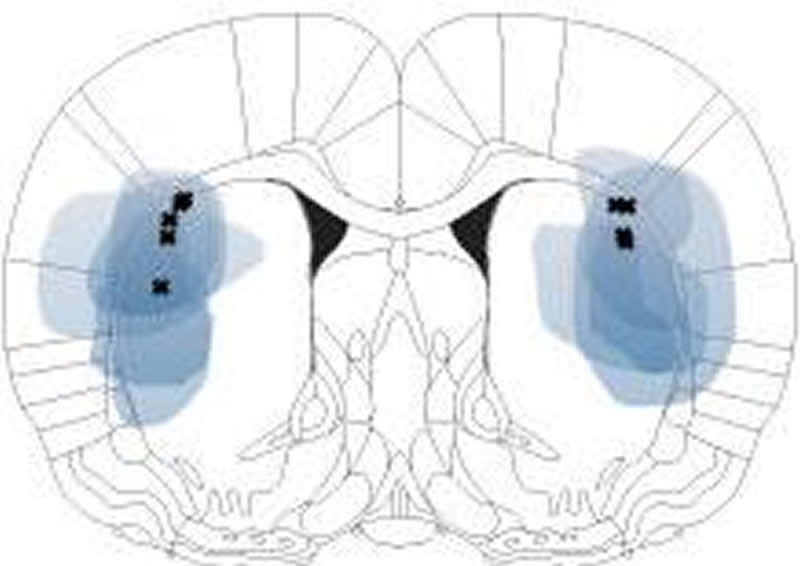Summary: As the brain starts to develop new habits, activity in the dorsolateral striatum increases. As the activity bursts increase, the habit becomes stronger. Inhibiting neural activity with optogenetics reduces habit behaviors in mice.
Source: Dartmouth College
Each day, humans and animals rely on habits to complete routine tasks such as eating and sleeping. As new habits are formed, this enables us to do things automatically without thinking. As the brain starts to develop a new habit, in as little as a half a second, one region of the brain, the dorsolateral striatum, experiences a short burst in activity. This activity burst increases as the habit becomes stronger. A Dartmouth study demonstrates how habits can be controlled depending on how active the dorsolateral striatum is. The results are published in the Journal of Neuroscience.
In prior research at MIT, the senior author found that this burst in brain activity in the dorsolateral striatum correlated with how habitual a running maze task was for rats. The activity was found to be accentuated at the beginning and end of the maze run.
For this study, the researchers sought to manipulate this burst in brain activity in rats using a method called optogenetics. With this method, the neurons (brain cells) in the dorsolateral striatum, which have been found to be associated with forming habits, can be excited or inhibited using light. Optogenetics enables the brain cells to express a receptor that is sensitive to light, and is painless. A flashing blue light excites the brain cells while a flashing yellow light inhibits the cells and shuts them down.
Using maze running tasks, rats were trained to run in a cross-shaped maze. (There was only one rat in a maze at a time). The rats began in one of two starting arms and ran from one end of the cross and ran to the center decision point. They were trained to turn either left of right and run to the end, where a sugar pellet reward was waiting; only one arm of the cross was baited with the reward. As soon as the animals started the maze run and turned in the correct direction of where the reward was located, they received a sugar pellet reward.
After the rats had learned the maze training runs, the optogenetics component of using the flashing color lights to manipulate the dorsolateral striatum activity, was incorporated. When the cells in the dorsolateral striatum were excited for just a half a second as the rats initiated their runs, the rats would run more vigorously and habitually on the entire maze. The habit had been formed, once the rats ran to the center of the cross-shaped maze and turned immediately towards the direction of where the reward was located. The animals would no longer stop at the center to look around, once they knew where to go.
In contrast, when the cells where inhibited, the rats were slow and appeared to lose their habit altogether. Once they reached the center of the cross-shaped maze, they paused and would turn around a lot as though deliberating, before ultimately making their choice. Even more striking, the researchers also tested how habitual the animals were by changing the tasty reward to something not tasty. In this case, the excitation made the rats continue running by habit for the now unpleasant outcome, while the inhibition made the rats essentially refuse to run when there was no reward to gain from it.

When the researchers applied the light manipulations during the middle of the runs on another day, there was little effect. Once the rats had already set in motion the full sequence of behavior – run, turn and stop sequence -this habit appeared to dictate their actions, as if they were on auto-pilot.
“Our findings illustrate how habits can be controlled in a tiny time window when they are first set in motion. The strength of the brain activity in this window determines whether the full behavior becomes a habit or not,” explained senior author, Kyle S. Smith, an associate professor and director of graduate studies in the department of psychological and brain sciences at Dartmouth, whose lab focuses on the neuroscience of reward and action. “The results demonstrate how activity in the dorsolateral striatum when habits are formed really does control how habitual animals are, providing evidence of a causal relationship,” he added.
Gaining a better understanding of the specific role that the dorsolateral striatum plays in habit memory and other behaviors is critical. Damage to this brain area has been found to be associated with Parkinson’s disease, a neurodegenerative disorder that often affects body movement. In the study, the researchers explain how targeting the time window as to when habits are formed could be leveraged in “designing intervention strategies for humans with otherwise treatment-resistant compulsive behaviors.”
Source:
Dartmouth College
Media Contacts:
Amy D. Olson – Dartmouth College
Image Source:
The image is credited to Kyle S. Smith et al.
Original Research: Closed access
“Complementary control over habits and behavioral vigor by phasic activity in the dorsolateral striatum”. Adam C.G. Crego, Fabián Štoček, Alec G. Marchuk, James E. Carmichael, Matthijs A.A. van der Meer and Kyle S. Smith.
Journal of Neuroscience doi:10.1523/JNEUROSCI.1313-19.2019.
Abstract
Complementary control over habits and behavioral vigor by phasic activity in the dorsolateral striatum
Despite clear evidence linking the basal ganglia to the control of outcome insensitivity (i.e., habit) and behavioral vigor (i.e., its speed/fluidity), it remains unclear whether or how these functions relate to one another. Here, using male Long Evans rats on response- and cue-based maze running tasks, we demonstrate that phasic dorsolateral striatum (DLS) activity occurring at the onset of a learned behavior regulates how vigorous and habitual it is. In a response-based task, brief optogenetic excitation at the onset of runs decreased run duration and the occurrence of deliberative behaviors, while mid-run stimulation carried little effect. Outcome devaluation showed these runs to be habitual. DLS inhibition at run-start did not produce robust effects on behavior until after outcome devaluation. At this time, when plausibly the DLS was most critically required for performance (i.e., habitual), inhibition reduced performance vigor measures and caused a dramatic loss of habitual responding (i.e., animals quit the task). In a second cue-based ‘beacon’ task requiring behavior initiation at the start of the run and again in the middle of the run, DLS excitation at both time points could improve the vigor of runs. Post-devaluation testing showed behavior on the beacon task to be habitual as well. This pattern of results suggests that one role for phasic DLS activity at behavior initiation is to promote the execution of the behavior in a vigorous and habitual fashion by a diverse set of measures.
SIGNIFICANCE STATEMENT
Our research expands the literature twofold. First, we find that features of a habitual behavior that are typically studied separately (i.e., maze response performance, deliberation movements, running vigor, and outcome insensitivity) are quite closely linked together. Second, efforts have been made to understand ‘what’ the dorsolateral striatum (DLS) does for habitual behavior, and our research provides a key set of results showing ‘when’ it is important (i.e., at behavior initiation). By showing such dramatic control over habits by DLS activity in a phasic time window, plausible real-world applications could involve more informed DLS perturbations to curb intractably problematic habits.






